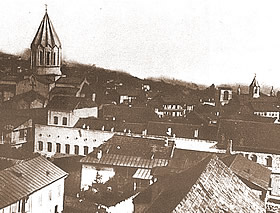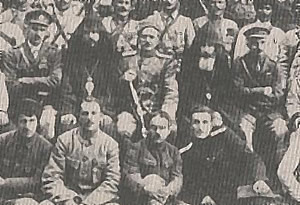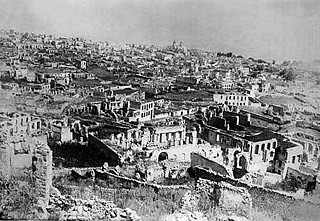History of Karabakh (part 2)
The Meliks
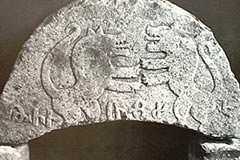 Coat of arms of the Melikdom of Gyulustan From the late 16th century, the Armenian Princes of Artsakh, nicknamed Meliks of Karabakh began to unite into the military unions. The five of the most influential Meliks forming the so-called Country of Five were Melik of Gulistan, Melik of Dgeraberd, Melik of Khachen, Melik of Dizak and Melik of Varanda. The Meliks of Karabakh headed the Armenian liberation movement until the late 18th century. At the same time, the spiritual leaders of Artsakh spared no efforts in order to establish diplomatic contacts with the most influential Russian and European leaders. A number of outstanding patriots, such as Israel Ori, spent many years of their life traveling throughout the Europe in attempt to find support of Christian powers. Unfortunately, their activities brought little results.
Coat of arms of the Melikdom of Gyulustan From the late 16th century, the Armenian Princes of Artsakh, nicknamed Meliks of Karabakh began to unite into the military unions. The five of the most influential Meliks forming the so-called Country of Five were Melik of Gulistan, Melik of Dgeraberd, Melik of Khachen, Melik of Dizak and Melik of Varanda. The Meliks of Karabakh headed the Armenian liberation movement until the late 18th century. At the same time, the spiritual leaders of Artsakh spared no efforts in order to establish diplomatic contacts with the most influential Russian and European leaders. A number of outstanding patriots, such as Israel Ori, spent many years of their life traveling throughout the Europe in attempt to find support of Christian powers. Unfortunately, their activities brought little results.
Khanate of Karabakh
With the Turkish advance eastward in the 20s of the 18th century, the Armenians of Karabakh and Siunik united under the leadership of David-Bek. Supported by Mkhitar Sparapet, David-Bek organized the successful defense. As a result, Karabakh and Siunik remained under the Armenian control.
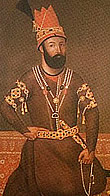 Portrait of Shah Nadir, by unknown author, from Victoria & Albert Museum, London
Portrait of Shah Nadir, by unknown author, from Victoria & Albert Museum, London
As the Meliks fought against different Turkish tribes, some Persian rulers, such as Nadir Shah (1732-1747) often encouraged them. The Persian policy changed, however, in the middle of the 18th century. The Shahs of Zand dynasty began to support the leaders of nomadic Saridjalli tribe, in their systematic incursions to Artsakh. First, a certain Panah-Ali was able to capture the fortress of Shushi and proclaim him-self Khan. Then his son Ibrahim took advantage of the continuous strife between the Meliks and captured the Monastery of Gandzasar. Ibrahim gradually subdued the whole of Artsakh, founding the so-called Khanate of Karabakh.
The Russian expansion
The Persian-Turkish yoke lasted until the beginning of the 19th century. Following the Russian expansion, Persia gradually ceded to Russia most of the Caucasus including Karabakh. The Treaty of Gulistan signed in 1813, asserted the Russian annexation. Evolving the expansion, Russian czar Nicholas I began the new war with Persia in 1826. During the Persian counterattack, the Persian army besieged Shushi in the summer of 1826. Armenian peasants and volunteers, supported by a small Russian garrison offered a fearless resistance. After 48 days of fighting, the Persians fell back. The war ended in 1828 with the Russian acquisition of Yerevan and Nakhichevan Khanates. Thus, the Eastern Armenia was definitely attached to the Russian Empire.
Shushi
According to the Russian administrative division of 1840, Karabakh was part of the Caspian Guberniya. Following the new Ukase of 1867, it was attached to the Elizavetopol Guberniya. Shushi, which became city in 1847, grew into the one of important centers of Caucasus, in which trade and commerce flourished rapidly. Shushi also became the center of the Armenian enlightenment and culture. Before 1917, 22 newspapers were published in Shushi (20 in Armenian language, and 2 in Russian).
Claims to Armenian lands
The Russian Revolution of 1917 put an end to czarist administrative division of Caucasus. In March of 1918, the Armenian, Georgian and Moslem leaders of Caucasus united to form an independent multiethnic Transcaucasian Confederation. The Confederation was, however, shortly dissolved, due to strong divergences between the tree peoples. The complete evacuation of Russian armies left the entire region defenseless in the face of the Turkish aggression.
On May 27, the Moslem deputies of the Confederation proclaimed a Musavatist Republic of Azerbaijan. The new Turkish state immediately laid claims to the entire territory of the former Elizavetopol Guberniya. Nun Pasha, commander of Ottoman forces, made an ultimatum to the Armenians of Karabakh to submit to Azerbaijan. In August, the Congress of Armenians of Karabakh unanimously rejected the ultimatum.
The Turkish invasion in Baku and Shushi
In September 1918, the Turkish forces invaded Baku, unleashing ruthless massacres of the peaceful Armenian population. Afterwards, the Turkish army entered Shushi. The war was impending, as the army of Armenian volunteers led by General Andranik approached Karabakh for help. However, General Thompson, British Commander of Caucasus stopped Andranik, promising to solve the problem during the Paris Peace Conference. In the summer of 1919, leaning on the British guaranty and trying to gain time and prevent the massacres, the 7th Congress of Armenians of Karabakh temporarily recognized the authority of Azerbaijan pending the final decision of the Paris Peace Conference.
Shushi destroyed
 General Khosrov Bey Sultanov, generally hated by Armenians of Karabakh, and later persecuted by Bolsheviks, fled to Turkey in 1923. However, shortly thereafter Britain began the withdrawal of its forces from Caucasus. The Paris Conference gave no result. Getting carte blanche for a definitive capture of Karabakh, the General Sultanov appointed governor of Karabakh presented a new ultimatum, demanding immediate attachment of Karabakh to Azerbaijan. Armenians rejected the ultimatum again.
General Khosrov Bey Sultanov, generally hated by Armenians of Karabakh, and later persecuted by Bolsheviks, fled to Turkey in 1923. However, shortly thereafter Britain began the withdrawal of its forces from Caucasus. The Paris Conference gave no result. Getting carte blanche for a definitive capture of Karabakh, the General Sultanov appointed governor of Karabakh presented a new ultimatum, demanding immediate attachment of Karabakh to Azerbaijan. Armenians rejected the ultimatum again.
In March 1920, after fierce fighting the Turkish forces invaded Shushi. Some 10,000 Armenians were killed and the city was burned to the ground. The arriving of the Armenian forces rescued the rest of population from the total annihilation.
On April 23, 1920 the 9th Congress of Armenians of Karabakh proclaimed Nagorno-Karabakh an integral part of Armenia.
Bolsheviks in Armenia
The situation changed again after the Russian Red Army annexed Azerbaijan. On April 28, 1920 Azerbaijan became a Soviet Republic. Now the Republic of Armenia began receiving ultimatums from both Soviet Azerbaijan and Russia to withdraw Armenian troops from Karabakh and Zanguezour. In May 1920, Karabakh was Sovietized by the 11th Red Army. However, the region remained independent de facto, for the Soviet Government declared it a “contestable” territory.
Meanwhile, the Republic of Armenia, facing both Turkish and Bolshevik aggressions was on the verge of total destruction. Despite numerous resolutions and agreements, such as the Treaty of Sèvres, bounding Turkey to return the Armenian lands, the Armenian government could not expect physical help from anywhere. On November 29, 1920 the power in Armenia was transferred to the Bolsheviks, and the country became a Soviet Republic. Surprisingly, on the next day a telegram was sent from the government of the Soviet Azerbaijan to the new Armenian government, declaring Karabakh, Nakhichevan and Zanguezour integral parts of the newborn Armenian Soviet Republic. This telegram was signed by Azerbaijan’s Bolshevik leaders Narimanov and Guseinov, who urged to “communicate the decision of Azerbaijan to the fraternal Armenian people”.


